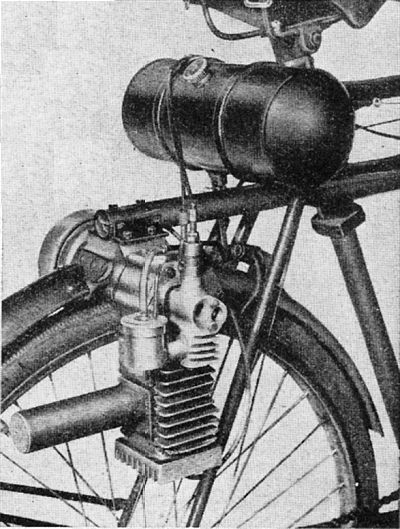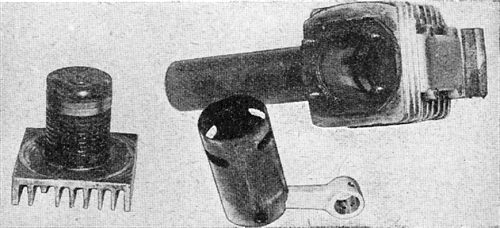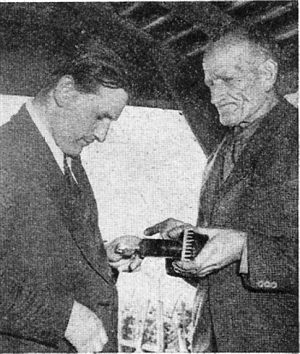 Go
to the Archive index
Go
to the Archive indexFOR many years, considerable efforts have been made to add to the efficiency of the simple two-stroke engine without bringing in unwanted complications. The result has been a diversity of designs, not all of which have been as sound in practice as original theory might have suggested.
A new development, pioneered by Mr. A. Fletcher, of Normandy, Surrey, may, however, point the way for a new type of two-stroke with several features of outstanding interest. Nor is the project purely theoretical, for several engines of the type have been built by its designer and tested in cyclemotor form.

The Fletcher engine, with its fuel tank,
mounted on to a normal pedal cycle.
Note the "built-in" carburetter and exhaust system.
Of the advantages claimed for the Fletcher engine, the most important are low weight, freedom from seizure and improved lowspeed pulling power. In construction, the Fletcher two-stroke differs fundamentally from conventional engines of the type, for the cylinder is a light-alloy casting with an unsleeved bore, in which operates a steel piston with skirts extended above its crown.
Ports are cut at the top of the skirts, and these, of course, correspond with ports in the alloy barrel. In place of the normal cylinder head is fitted a junk head, carrying two piston rings and provided with oil grooves. This head is a sliding fit within the piston, and has a deflector formed upon its crown opposite the transfer port.

The unusual components showing the cylinder head and static
"piston",
the mobile ported sleeve and the cylinder barrel proper.
Mixture is induced into the crankcase through a simple rotary valve and is transferred through a long transfer port in the normal way. Port timing is controlled in the usual way - i.e., by the relative movement between the ported piston (which can be considered as a form of moving cylinder barrel) and the junk-head, which forms in effect a static piston.
It will be seen, then, that in its operation the Fletcher cyclemotor does not differ materially from the normal three-port two-stroke. However, it has - as was stated earlier - a high resistance to seizure by reason of the greater degree of expansion of the alloy barrel compared with the steel piston.
Thus the barrel is always attempting to "outdistance" the piston, but owing to the fact that the latter component operates at a higher temperature, the net result is that the bore and piston tend to keep in step. Overheating of the junk-head, which might at first glance appear to be a possibility, has not been encountered. This may be due to the inverted position of the engine, which allows the junk-head to be given a reasonable supply of lubricant, and to the fact that the head is not constantly in contact with the piston walls, and thus has a series of "breathing spaces" during the operation of the engine.
With light alloy figuring so prominently in the design, it is not surprising to find that the weight has been kept to a minimum.
Thus, despite its capacity of 49 c.c., the engine weighs but 10 lb. complete - a not inconsiderable engineering achievement. When a Motor Cycling staffman recently visited Mr. Fletcher's workshop, he was shown the engine dismantled, and formed a very high impression of the degree of craftsmanship which has gone into its making.

Mr. Fletcher (right) describes the working of his
unit to "Motor Cycling's" John Thorpe.
All the alloy parts - even the carburetter - were cast by Mr. Fletcher himself, who also made all the necessary patterns. Machining was done on a lathe in the inventor's back-garden workshop (a lathe powered, incidentally, by yet another engine of this type, which runs quite happily without any form of forced cooling). The only major "bought-out" component is the Wico-Pacy flywheel magneto.
A patent is held by the inventor, who is seeking a commercial backer for the venture.
Our representative was given a most convincing demonstration of the abilities of the Fletcher engine. A main-road run of some miles duration indicated that the unit would propel a cycle at a steady 25 m.p.h., and that it was little affected by gradients.
Proof of this was forthcoming when tho long, tiring rise from Crawley to Pease Pottage, on the Brighton/London road, was tackled. This hill which - to our staffman's personal knowledge - sorely tries a machine of small capacity was climbed by tho Fletcher-powered cycle at a steady 20 m.p.h., without so much as a single twist of the pedals being required. Lesser "pimples" could be surmounted at higher speeds.
First published in Motor Cycling, July 1, 1954